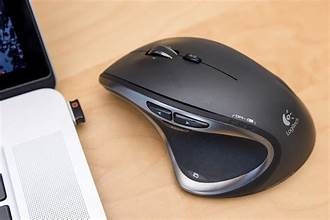A hotly debated topic in the world of PC gaming peripherals is wireless vs. wired gaming mice. A wireless mouse either uses a 2.4 GHz RF dongle or Bluetooth. If you’re interested in a Bluetooth gaming mouse, there are a few things that you should know first.
Here are 7 reasons why gamers should never buy a Bluetooth mouse:
- Bluetooth has a low polling rate on gaming mice.
- Bluetooth is inferior to 2.4 GHz wireless mode.
- A Bluetooth mouse needs a Bluetooth motherboard.
- Bluetooth is susceptible to interference.
- Bluetooth mice run out of battery.
- Bluetooth adds to the overall weight of the mouse.
- A Bluetooth mouse can lose connection in-game.
- A Bluetooth mouse lags on high refresh rate monitors.
- Bluetooth Low Energy (BLE) makes mice less accurate.
This article will take a deeper look at the reasons that make a Bluetooth mouse a bad choice for gaming. If you want a wireless mouse, I’ll also offer you a few much better, lag-free alternatives.
1. Bluetooth Has a Low Polling Rate on Gaming Mice
The polling rate on a gaming mouse essentially describes how many times the mouse checks the position on the screen per second.
For example, a gaming mouse with a polling rate of 1,000 Hz refreshes 1,000 times in a second. So, the higher the number, the better.
This isn’t the only factor to consider when buying a gaming mouse. However, the problem with Bluetooth mice is that the polling rate limit is only 133 Hz. 133 refreshes per second sounds like a lot, but that’s considered snail speed in the world of PC gaming.
This low polling rate leads to something known as input lag.
In a nutshell, input lag is the time that passes between you clicking or moving the mouse and the computer registering and processing it.
A wired or 2.4 GHz wireless mouse with a polling rate of 1,000 Hz has an input latency of 1 ms. Using a Bluetooth mouse set to 125 Hz, the input lag will be 8 ms.
Frankly speaking, you just can’t notice this minute 8 ms gap between your mouse click and the screen.
Only a professional FPS gamer might be able to discern between 1 ms and 8 ms.
However, just because you don’t feel the lag doesn’t mean that your game won’t. This lag is more than enough to get you killed by a well-aimed skill shot in League of Legends, even if you react in time to dodge it.
But why is Bluetooth limited to such a low polling rate?
The biggest problem with the Bluetooth protocol is that it’s entirely controlled by the Bluetooth Special Interest Group (SIG).
SIG cares about the stability and reliability of products with the Bluetooth label. There’s also Bluetooth Low Energy, or BLE for short, which limits bandwidth in favor of better battery life.
Spending time and money to develop a higher polling rate on gaming mice isn’t worth it for the Bluetooth SIG.
2. Bluetooth Is Inferior to 2.4 GHz Wireless Mode
If you’re looking for a wireless gaming mouse, you’ll come across hundreds of 2.4 GHz mice. Few of them support Bluetooth.
And you’ll be hard-pressed to find a gaming mouse that skips 2.4 GHz in favor of Bluetooth. Gaming peripheral brands don’t want their mouse to underperform.
The thing is, 2.4 GHz mice can achieve a polling rate of up to 1000 Hz.
In theory, there’s no performance difference between a 2.4 GHz and a wired gaming mouse. However, you can’t say the same for a slow Bluetooth mouse.
The 2.4 GHz RF band is used by your Wi-Fi router as well. It’s a congested frequency, but it’s still better than Bluetooth.
Using a 2.4 GHz mouse won’t make you lose matches. It’s more accurate with a significantly lower input lag.
Since 2.4 GHz mice exist, there’s no incentive to get a Bluetooth mouse.
3. A Bluetooth Mouse Needs a Bluetooth Motherboard
The odds of you having Bluetooth on your motherboard aren’t great.

Bluetooth is available on most high-end motherboards, some mid-end ones, and select low-end models.
You usually have to pay a bit extra to get Bluetooth on a PC motherboard.
Both Wi-Fi and Bluetooth aren’t super common on consumer-grade motherboards. It adds additional cost to the product, and most buyers don’t need them.
So, you’ll need a compatible motherboard with support for the latest Bluetooth technology to use a Bluetooth mouse.
Of course, there’s a cheaper alternative – you can get a Bluetooth USB adapter instead.
However, some – if not all – Bluetooth dongles will add even more input lag to the already slow mouse. So, you’d be adding even more input lag to an already laggy interface.
Compare this to 2.4 GHz or wired USB mice, which work with any motherboard.
4. Bluetooth Is Susceptible to Interference
A Bluetooth mouse uses the 2.4 GHz frequency band to communicate with your computer. This means that Bluetooth mice have some notable similarities with 2.4 GHz wireless mice.
Unfortunately, all wireless gaming mice are somewhat susceptible to interference. 2.4 GHz is also used by thousands of other household devices, such as your microwave, baby monitor, and Wi-Fi router.
If your house is full of smartphones, tablets, and wireless gadgets, your Bluetooth mouse will inevitably suffer from interference.
Please note that this will happen with a 2.4 GHz mouse as well. In this case, a wired mouse is the best choice.
5. Bluetooth Mice Run Out of Battery
A wireless mouse runs on batteries, and that’s an enormous issue for gaming. You’ll either have to change the batteries or recharge your Bluetooth mouse every few days to every few weeks.
It’s important to note that most cheaper Bluetooth mice use regular AAA batteries that you can buy anywhere. These aren’t exactly fun to use. And they’re horrible for the environment, like other disposable items.
There are a few different solutions to this problem. For example, Razer uses charging docks for their wireless mice.
Other manufacturers like Steelseries use a regular Micro-USB or USB Type-C port to charge the mouse. This allows you to at least use the mouse while it’s charging.
Some even sell an expensive (but useful) wireless charging pad, like the Logitech Powerplay.
However, all these workarounds are something a wired mouse user never has to deal with. Running out of juice in the middle of a game will leave you angry, frustrated, and with a ‘Defeat’ in your match history – and you’ll never have to deal with these issues with a wired mouse.
6. Bluetooth Adds to the Overall Weight of the Mouse
Pretty much all wireless mice weigh slightly more than their wired counterparts.
A Bluetooth mouse has an additional Bluetooth module built-in.
A notable exception is the Logitech G502 Lightspeed, which is a bit lighter than the wired model. But this is because of minor changes and improvements in the model.
So, why is all that extra weight bad?
A heavier gaming mouse makes it harder to remain accurate in FPS games. It’ll also tire your hand out sooner. The added fatigue builds up day after day, resulting in a painful wrist condition known as carpal tunnel syndrome (CTS).
7. A Bluetooth Mouse Can Lose Connection In-Game
There are few things in life that are more annoying than your connection dropping. Unfortunately, it’s also a fairly common event when using a Bluetooth mouse.
It usually happens only for a second or two. But you AFKing in the middle of a match is usually enough to get you picked by an enemy sniper.
The most frustrating thing about it is that you sometimes have to reconnect the mouse manually.
You have to Alt + Tab in the middle of a match and navigate through complex Windows settings to find Bluetooth. But how can you even do that if the mouse isn’t responding?
You get the point.
So, users usually resort to restarting the mouse. That involves taking the batteries out and putting them back in. Or maybe there’s a reset button on the bottom.
Whatever the method, this isn’t something you should ever have to deal with.
8. A Bluetooth Mouse Lags on High Refresh Rate Monitors
Remember all that talk about polling rates on different gaming mice earlier? Here it is again.
If you’re a gaming veteran, you probably have a high refresh rate monitor. 144 Hz monitors are extremely affordable nowadays, with 240 Hz and even 360 Hz growing in popularity.
Let’s say you’re using a 240 Hz monitor. That means the screen updates 240 times every single second.
So, what happens when you use a 240 Hz monitor with a 125 Hz Bluetooth mouse?
An enormous input delay, that’s what. It may even become so severe that you actually start noticing it.
You’ll be able to feel a minor delay between you moving the mouse and the action happening on screen. It’s especially noticeable in first-person games because of the camera angle.
Input lag is already bad enough when you can’t see it. However, when you have a very fast monitor, it becomes a massive bottleneck in your skill and enjoyment.
9. Bluetooth Low Energy (BLE) Makes Mice Less Accurate
Bluetooth Low Energy was introduced with Bluetooth 4.0, so it’s not some new special technology.
The problem with BLE is that it uses something called lazy frequency hopping. As the name suggests, it adds a long delay between changes in frequency.
This results in dropped data packages between your mouse and the computer. It causes your mouse to be unresponsive for a few seconds, which feels as if your computer froze completely.
BLE adds yet another layer of unreliability in the Bluetooth connection.
Is There Any Benefit to Using a Bluetooth Mouse for Gaming?
The one benefit of using a Bluetooth mouse for gaming over a wired mouse is that there’s no wire dragging along on the desk. This makes a Bluetooth mouse feel much better. It’s also easier to use with laptops and while traveling.
You can probably tell by now that the downsides of Bluetooth mice far outweigh the pros.
Sure, a wireless mouse looks tidier on the desk. But that just can’t justify either the added input lag and weight or the need to deal with batteries.
Bluetooth is too slow and unreliable to use for gaming.
The Best 2.4 GHz Wireless Gaming Mice
If you must have a wireless mouse, get a 2.4 GHz one.
You can even get a model that has both 2.4 GHz and Bluetooth so that you can use Bluetooth without a dongle with your laptop. It’s not ideal, but it’s good enough for productivity or light gaming.
Without any further ado, here are a few high-end 2.4 GHz gaming mice (all of which are available on Amazon.com) that you should consider instead of a cheap Bluetooth model.
Logitech G502 Lightspeed
Admittedly, I’m partial to the G502 because I own one. The aesthetics are oriented toward gamers, so that’s something that you should be aware of.
The Lightspeed model weighs less than the wired one. It features 11 fully programmable buttons with the G Hub program.
Most importantly, it uses the laser-accurate 25K DPI Hero sensor. Combined with a polling rate of 1000 Hz, this mouse is perfect for all game genres. However, this mouse doesn’t support Bluetooth, so you don’t have the flexibility of having options.
SteelSeries Rival 3
If you can’t live without Bluetooth, here’s a mouse that stands out from the competition. It has both 2.4 GHz and Bluetooth, so you’ll have endless freedom with it.
Additionally, the battery lasts for a whopping 400+ hours.
It uses an accurate 1-to-1 TrueMove Optical 18,000 CPI sensor. So, you don’t have to worry about dying in-game because of your mouse.
Corsair Harpoon
Can’t decide between wired, 2.4 GHz, or Bluetooth? The Corsair Harpoon supports all of them!
You can choose between the <1 ms Corsair Wireless dongle, low-latency Bluetooth, or a regular old USB cable.
It’s a high-end gaming mouse that lasts for 60 hours of gaming between charges, and it uses a high-end 10,000 DPI sensor for superior accuracy.







